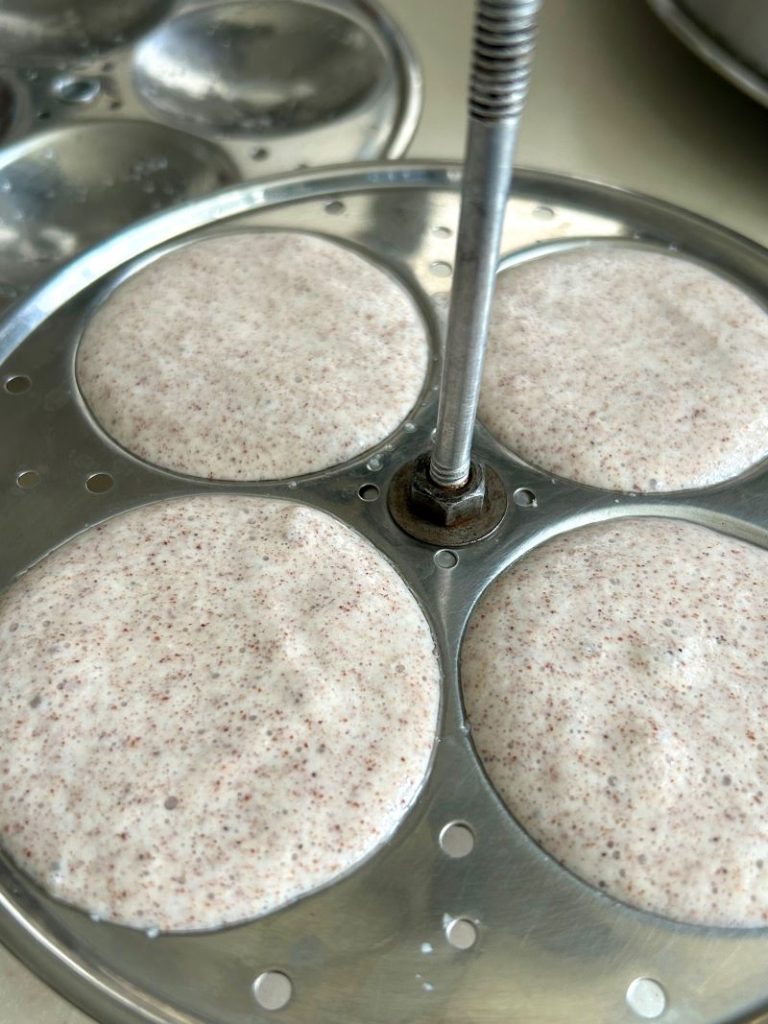
At home Idlis is our favourite breakfast. Ragi idli is a nutritious wholesome South Indian meal. They are light, easy on stomach and have tremendous health benefits. Idlis are like steamed cakes made with lentils and idli rice. Ragi idli is just another variation where ragi is replaced by rice. The batter of these ragi idlis will also be beneficial for making dosas the next day. I like to serve these millet idlis with Coconut Chutney or Kara Chutney.
Ragi idli is made using idli rice, flattened rice (poha), ragi flour, urad dal and fenugreek seeds. The ingredients are first soaked and then the batter is prepared by grinding the ingredients followed by fermentation, then the batter is steamed to make idlis. This batter yields consistent results. The idlis will always be pillowy soft and totally melt in mouth.
Not just Ragi idlis or dosas, if you are a pancake lover, you can also try these, Ragi Pancakes or these Millet Cutlets which you can easily make at home in 10 minutes using minimal oil. They come out absolutely delicious and are so healthy.
Given the health benefits of ragi, these steamed cakes become a superfood which not only has benefits of whole grains, but it is also fermented.

Why fermented food is good for you?
Fermented foods like idli, dhokla, dosa are a fabulous addition to your diet.
- It helps in increasing immunity and improves digestion.
- It also increases the bio availability of minerals. It breaks down proteins, carbohydrates and other minerals in a way making it easily available to our body.
- Also a lot of good bacterias are at play when your food is fermenting. All fermented foods are natural probiotic. It’ll strengthen your immune system making you disease resistant.
- The lactic acid bacteria which helps in fermentation also creates omega 3 fatty acids, essential for the immune system. It will help to remove toxins and helps your body build a healthy gut flora.
Here are 5 excellent reasons why this millet should be in your diet.
- High fibre content: Ragi is high in dietary fibre which will help to promote proper digestion and keep your bowel movements in check.
- Rich in Calcium: It is an ultimate non-dairy source of calcium. Just 100 grams of Ragi can give you 344 mg of calcium.
- Supports Gluten- Free Diet: Ragi is a great choice if you are on a gluten-free diet – it’s naturally gluten-free! No need to worry about hidden gluten as it’s a safe and delicious way to enjoy your meals.
- Child Nutrition: It helps to fulfil child’s nutritional needs. It is rich in protein, calcium, iron, zinc and other essential nutrients.
- Treats Anaemia: Since Ragi is an excellent source of iron too, which is essential for producing red blood cells, it helps to fight off anaemia.
With all such goodness and nutrition packed in this humble dish, let’s get to the recipe now
Recipe: serves 4
Ingredients: measuring cup size 250 ml
- Ragi flour: 1 cup
- Idli Rice/Parboiled Rice or Broken Rice: 1 cup
- White Split Urad dal: 1/2 cup
- Flattened Rice/Poha: 1/4th cup
- Fenugreek seeds/Methi dana: 1/4th tsp
- Rock Salt or any non-iodised salt: As per taste
- Oil/ghee for greasing
- Water as required for making batter and steaming
Method:
- Wash rice and poha 3 to 4 times. Soak them in enough water for 5 hours.
- Wash urad dal and fenugreek seeds 3 to 4 times and soak for 5 hours.
- Drain the water from dal and rice. First grind urad dal to a smooth and fluffy batter. Add little water at a time to get a smooth paste. Do not add too much water in one go.
- Then grind rice and poha to a smooth batter using water as required. Again, don’t add too much water. Add little at a time.
- In large steel bowl, mix together both dal and rice batter.
- Add roughly 3/4th cup of water to ragi flour and make a smooth consistency batter. Make sure there are no lumps.
- Mix Ragi batter with rice and dal batter till it completely incorporates.
- Add rock salt as per taste. Cover the bowl with a lid and keep the batter in dark warm place for 9 hours or more. I had to keep it for 12 hours.
- The batter will double and become fluffy and airy. Give a gentle mix before making the idlis. Do not mix rigorously or you will lose the airiness of the batter.

- In an idli maker, bring water (roughly 3″ above) to boil. Grease idli moulds with oil/ghee. Fill in the cavities with the batter.

- Now, steam the idlis in idli maker for 10 to 12 minutes or till toothpick inserted at the centre comes out clean. It shouldn’t be sticky.
Tips for fermentation: –
- Add rock salt to the batter before fermenting. Salt helps in fermentation. Do not use iodised salt.
- Do not skip Fenugreek seeds. It helps the batter to get bubble like texture. Also, it’s makes dosa crispier.
- Add enough water while grinding dal and rice to get smooth and fluffy batter. Do not add water in one go. Keep adding little at a time. This will give you soft idlis.
- Mix the final batter with your hands for a minute and then keep it at a warm place. The warmth in your hand will help in fermentation.
I hope you enjoyed reading this recipe and will give it a try. Do let me know if you do. I would love to hear from you guys. Here’s to healthy eating! 🙂












